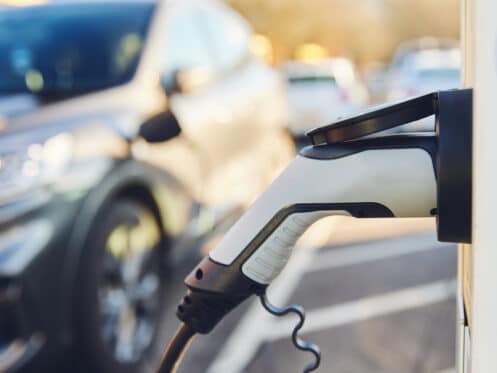If you have a hybrid or fully electric vehicle, installing an EV charging station at your home will make your life more convenient. A home charging station will also save you lots of time and money compared to constantly having to use public charging stations. If you are considering a home EV charging station, here is everything you need to know about your different options, how EV chargers are installed, and the things you need to consider when choosing a charging station.
Level 1 vs. Level 2 EV Charging
All hybrids and fully electric vehicles can use both Level 1 and Level 2 charging. A Level 1 charger is convenient since all you have to do is plug the vehicle into any standard 120-volt outlet without needing any special equipment other than the cord that came with your EV. The only problem is that Level 1 charging is painfully slow and will typically only give you a range of around 2 to 5 miles for every hour of charging. Depending on the total range of your vehicle, you’ll usually need to leave it plugged in for at least 40 hours for the battery to charge to 80% of its total capacity.
Level 1 charging is usually sufficient if you have a short commute and never drive that many miles in a day. In this case, leaving your vehicle plugged in to charge overnight would usually provide enough range that you won’t need to worry about the battery going dead on your way home from work. That said, Level 2 charging stations are much more convenient and will charge your vehicle much faster and provide you with a far greater range.
A Level 2 EV charger runs off a 240-volt circuit instead of 120-volt like Level 1 charging, and the higher voltage is what allows a Level 2 station to charge must faster. Each hour of charging on a Level 2 station will provide you with around 30 miles of range on average, but the range can vary anywhere from 10 to 75 miles depending on your vehicle and the specific model of the charging station. This means that a Level 2 station can allow you to fully charge your battery in only a few hours. You could even charge two EVs from the same charging station by plugging one in when you get home from work and then switching and plugging the second one in before you go to bed.
One thing to note is that charging more slowly is better for the life of your EV battery as it generates less heat. This means that you may still want to use Level 1 charging in situations where your battery still has lots of life left or you know you won’t need to drive very far the next day. Some people also recommend using Level 1 to “trickle charge” your battery once it starts nearing full capacity. However, this really isn’t necessary since most Level 2 stations will automatically regulate the charging speed. They will charge at full speed when the battery is low, but then start to slow down the rate of charging when the battery reaches a certain capacity. This helps to protect the lifespan of the battery by reducing the amount of heat while still ensuring it will receive a full charge.
How a Type 2 Charging Station Is Installed
A Level 2 charging station can be installed inside your garage or outside your home near where you normally park. Installing the station inside is the best option when possible since EVs charge quite a bit more slowly in cold temperatures.
In either case, the first thing an electrician will need to do is run wires from the electrical panel and install a new 240-volt circuit. Like any other 240-volt appliance or device, a Level 2 station has to be on an independent circuit that provides power to it and nothing else. If you already have a 240-volt outlet in your garage, you can just use this for the charging station but you won’t be able to use it for anything else anymore.
In certain cases, you may need to have your electrical panel upgraded when installing a Level 2 charging station. If there is no room in the electrical panel to add a new 240-volt circuit and a double-pole circuit breaker, the electrician may just be able to install a sub-panel in the garage as long as the existing panel is high enough amperage.
If your panel only has a 100-amp service, you will need to upgrade to a 200-amp panel to ensure it can still provide enough power to all of the other circuits whenever you’re charging your vehicle. If you have a large home and many high-power appliances like a central AC, home theater, electric clothes dryer, hot tub, or jet tub, you may need to upgrade to a 400-amp panel instead. In this case, a 200-amp panel typically wouldn’t be sufficient to run that many 240-volt circuits and all of the other things in the home.
The reason that you may need to upgrade your electrical panel is that a Level 2 charger needs a 240-volt, 50-amp circuit. As such, the electrician will need to evaluate your home to ensure that the panel supplies enough amps at one time. If the panel doesn’t have sufficient amps, you’ll also often have issues with lights flickering and some circuits not having sufficient power when your vehicle is plugged in.
Once the circuit is installed, the electrician will then either hardwire the charger to the circuit or install a special 240-volt plug. This step depends on whether you choose a hardwired or a plug-in charger.
How to Choose the Right Level 2 Charging Station
Deciding between a plug-in or hardwired charger is an important consideration when choosing the specific brand and model of Level 2 station you want, as both types have some advantages and drawbacks. Hardwired chargers will typically charge a bit faster since they are wired directly to the electrical panel. They are also more reliable since you won’t need to worry about the plug accidentally getting knocked loose from the outlet.
The main advantage of a plug-in charger is that you can take it with you. However, this isn’t as convenient as it may sound since it can only be plugged into a special NEMA 14-50 outlet, which is the same type of outlet most dryers plug into and is not something that you’ll often encounter. Plug-in chargers also sometimes have more issues with voltage drops, which can make them less reliable. On the other hand, a plug-in charger will allow you to use the 240-volt outlet for other things, such as charging the batteries on a larger RV.
Hunt’s Services is ready to help if you’re looking to install a home EV charging station in the Tacoma and Puget Sound area. We happily provide free estimates on all EV charger installations, and our team can also upgrade your electrical panel if necessary. We also specialize in all other electrical installations and can take care of your electrical inspection and repair needs as well. For more information on your options for home EV charging or to schedule any electrical, HVAC, or plumbing service, give us a call today.




